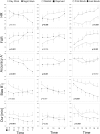Effects of night work, sleep loss and time on task on simulated threat detection performance
- PMID: 18788650
- PMCID: PMC2542965
Effects of night work, sleep loss and time on task on simulated threat detection performance
Abstract
Study objectives: To investigate the effects of night work and sleep loss on a simulated luggage screening task (SLST) that mimicked the x-ray system used by airport luggage screeners.
Design: We developed more than 5,800 unique simulated x-ray images of luggage organized into 31 stimulus sets of 200 bags each. 25% of each set contained either a gun or a knife with low or high target difficulty. The 200-bag stimuli sets were then run on software that simulates an x-ray screening system (SLST). Signal detection analysis was used to obtain measures of hit rate (HR), false alarm rate (FAR), threat detection accuracy (A'), and response bias (B"(D)).
Setting: Experimental laboratory study
Participants: 24 healthy nonprofessional volunteers (13 women, mean age +/- SD = 29.9 +/- 6.5 years).
Interventions: Subjects performed the SLST every 2 h during a 5-day period that included a 35 h period of wakefulness that extended to night work and then another day work period after the night without sleep.
Results: Threat detection accuracy A' decreased significantly (P < 0.001) while FAR increased significantly (P < 0.001) during night work, while both A' (P = 0.001) and HR decreased (P = 0.008) during day work following sleep loss. There were prominent time-on-task effects on response bias B"(D) (P= 0.002) and response latency (P = 0.004), but accuracy A' was unaffected. Both HR and FAR increased significantly with increasing study duration (both P < 0.001), while response latency decreased significantly (P <0.001).
Conclusions: This study provides the first systematic evidence that night work and sleep loss adversely affect the accuracy of detecting complex real world objects among high levels of background clutter. If the results can be replicated in professional screeners and real work environments, fatigue in luggage screening personnel may pose a threat for air traffic safety unless countermeasures for fatigue are deployed.
Figures




References
-
- Department of Homeland Security's website. [last visited on 02/02/2007. 2007]. ( www.dhs.gov/xtrvlsec/
-
- Doran SM, Van Dongen HP, Dinges DF. Sustained attention performance during sleep deprivation: evidence of state instability. Archives Italiennes de Biologie: A Journal of Neuroscience. 2001;13:1–15. - PubMed
-
- Dorrian J, Rogers NL, Dinges DF. Psychomotor vigilance performance: a neurocognitive assay sensitive to sleep loss. In: Kushida CA, editor. Sleep deprivation: clinical issues, pharmacology and sleep loss effects. New York, NY: Marcel Dekker, Inc.; 2005. pp. 39–70.
-
- Durmer JS, Dinges DF. Neurocognitive consequences of sleep deprivation. Semin Neurol. 2005;25:117–29. - PubMed
-
- Dinges DF, Kribbs NB. Performing while sleepy: effects of experimentally-induced sleepiness. In: Monk TH, editor. Sleep, sleepiness and performance. Chichester, United Kingdom: John Wiley and Sons, Ltd.; 1991. pp. 97–128.
Publication types
MeSH terms
Grants and funding
LinkOut - more resources
Full Text Sources
Other Literature Sources
Medical
